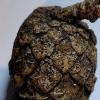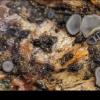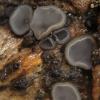
21-02-2016 00:08
 Rubén Martínez-Gil
Rubén Martínez-Gil
Hola a todos. Subo unas fotos de un asco que hemo

19-02-2016 00:38
 Lothar Krieglsteiner
Lothar Krieglsteiner
.. found today in the reserve Fonte Benemola, but

19-02-2016 23:38
 Bernard CLESSE
Bernard CLESSE
Bonsoir à tous,Voici ce que je pense être un Orb

19-02-2016 22:09
 Bernard CLESSE
Bernard CLESSE
Je suppose que vous le connaissez mais comme on ne

16-02-2016 21:31
François BartholomeeusenHi all,Found on dead stalk of Rubus lying on the g

19-02-2016 00:05
Olsson JanFound these on fallen twigs of Fraxinus. Is it pos

16-02-2016 17:29
 Blasco Rafael
Blasco Rafael
Hola, he encontrado esta muestra en estiercol de c
Possible Mollisia atlantica on a cone of Pinus sylvestris
B Shelbourne,
15-11-2024 20:08
• Mollisia suggested by excipulum and paraphyses.
• I struggled with Ingo's key but ended up around 58. M. scopiformis cf. (ellipsoid spored).
• Micro seems similar to M. atlantica.
Habitat: On a Pinus sylvestris cone, often close to the edges of the scales, under several large trees, on a hill, 208 m alt., Old Lodge nature reserve, Ashdown Forest, High Weald, southern England, early-November.
Apothecia: Diameter < ~1.25 mm, cupulate to discoid-pulvinate, dark grey with a lighter margin and eventually all light grey, often undulating or lobate, gregarious to 4+ caespitose.
Macro: Initially dark grey and globose-urceolate, receptacle with more pruinose appearance, olive coloured, gradually lightening on the flanks towards the margin, margin soon becoming whitish, remaining raised above the disc, disc becoming whitish with maturity, smooth and more gelatinous appearance, becoming plane, possibly with a localised blackish subiculum, no yellow reaction in KOH.
Asci: Turgid ~65-70 x 7.5-8.5 um, croziers, rings bb, 2-3-seriate.
Spores: Ellipsoid to slightly clavate, 1-septate in the asci, often homopolar but sometimes basal cell more elongated, OCI 0 but very lowly refractive, many spores dying quickly, becoming smaller and appear empty.
Free living spores in water: (8.6) 9.1-11.0 (11.7) × 2.4-3.0 (3.3) µm, Q = (3.1) 3.4 - 4.0 (4.5), N = 25, mean = 10.0 × 2.7 µm, Q mean = 3.7.
Paraphyses: Cylindrical, gradually widening towards the apex, ~3 um wide, filled with large cylindrical VBs, apparently few septa, apical cell appears ~2x longer than cell below.
Medullary: Shallow, hyaline-yellowish, text. porrecta.
Ectal: Text. globosa-angularis, brownish becoming olive in KOH, blackish at the surface, at the base with brown exudate and irregular hyphae.
Marginal cells: At the margin ~30-40 x 5 um, shorter and brown at the upper flanks, at the margin hyaline, with refractive VBs in the apical 2-3 cells, apical cell subglobose or more narrow and slightly asymmetric.
Hans-Otto Baral,
15-11-2024 21:01

Re : Possible Mollisia atlantica on a cone of Pinus sylvestris
Surely it is. My impression was that it is frequent in the atlantic area. But why it seems undescribed I do not understand.
Please tell me the date of collection, also for T. sulphurea.
Michel Hairaud,
16-11-2024 11:01

Re : Possible Mollisia atlantica on a cone of Pinus sylvestris
Hi,
I agree, this species is fairly common in the Atlantic area, at least in Center West of France , on all kinds of substrates , includinc dead wood, conifers cones, Ruscus dead stems...
Amitiés. Michel
I agree, this species is fairly common in the Atlantic area, at least in Center West of France , on all kinds of substrates , includinc dead wood, conifers cones, Ruscus dead stems...
Amitiés. Michel
B Shelbourne,
16-11-2024 12:49
Re : Possible Mollisia atlantica on a cone of Pinus sylvestris
Thank you both. The micro seems broadly similar to M. cinerea s.l. and M. amenticola, but the frequency of septate spores and septation within living asci was noticeable.
I see from a comment on this forum that Andreas Gminder was planning to publish this species several years ago.
T. sulphurea: 06/11/24
M. atlantica: 08/11/24
Hans-Otto Baral,
16-11-2024 17:06

Re : Possible Mollisia atlantica on a cone of Pinus sylvestris
Thanks! In my area I was unable to find a Mollisia with septate spores inside the living asci. But in atlantic or mediterranean areas such species exist, although in a low number.





 Hymenium-0030.jpeg
Hymenium-0030.jpeg